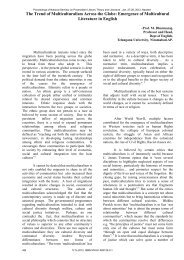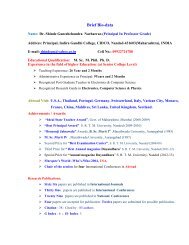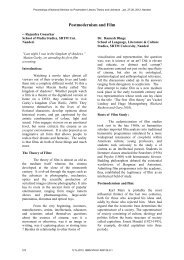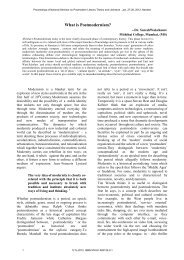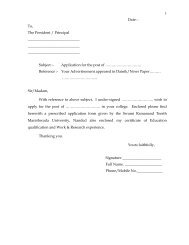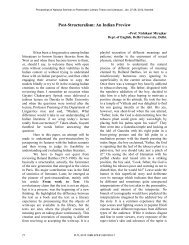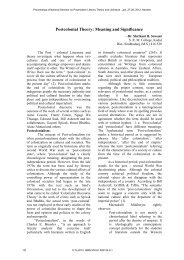Postcolonial Feminist Theory: An Overview - Igcollege.org
Postcolonial Feminist Theory: An Overview - Igcollege.org
Postcolonial Feminist Theory: An Overview - Igcollege.org
You also want an ePaper? Increase the reach of your titles
YUMPU automatically turns print PDFs into web optimized ePapers that Google loves.
Proceedings of National Seminar on Postmodern Literary <strong>Theory</strong> and Literature , Jan. 27-28, 2012, NandedRavindranath Tagor's Chitra in Post-modern <strong>Feminist</strong> Perspective--Ms. Nakade Meera M.Shri Yoganand Art's College,Basmath.Dist. Parbhani (MS)Post - modernism is not a single termbut was paralleled by other theories like Post -colonialism, Post-structuralism, Reader-responsetheory, New Historicism, Marxism andFeminism also. The term Post-modernism firstoriginated in 1930's by Jean Francois Leotrad'sThe post-modern condition : A report onknowledge (Manchester university press 1979).The age highlighted many importantcharacteristics like absurdity, age of virtualreality, consumerism, capitalism, super market,federation of culture, age of flux, cyber age, lossof faith in god and religion.Feminism is called as women'smovement of the 1960's by asking questionsabout their inequality in society. It is a women'soutlook at everthing. It is political ideology bymale that challenges the roles of male dominatedsociety and feminism tries to expose themechanism of patriarchy in works of art. Thusfeminism is a movement by women, for womenand for the sake of women about the vindicationof rights to overthrow socio-political andeconomic oppression by male world and herthrust for self identity, self help, self knowledgeand self realization which leads to mutualunderstanding between both the sexes.Feminism is basically a western termwhich is derived from a series of twentiethcentury founding texts of Virginia Woolf's "Aroom of one's Own" (1029), Simon DeBeauvoir's "The Second sex" (1949), KateMillet's Sexual politics and earlier works byMary Wellstone Craft's "Vindication of TheRights of Women" and John Stuart Mill's ;"Subjection of Women". All these books are builtupon feminist literature and tried to expose malepolitics, their double standard of sexual moralityand stereotype representation of women and soon. It resulted a kind of boost in women andgave birth to the image of new woman inliterature who tried to fight against maledominated culture, tradition, religion and so on.Rebhindranath Tagore's era was full ofinjustic and cruelty towards women, sati rite,polygamy, widows are not allowed to remarry,an unjust cast system was prevalent in socity.Under these circumstances Manisha Roycomments about him as, "Ravindranath Tagoreis the first modern Indian writer who brought hiswomen out of the kitchen and bed room in to theparlour where they argue with men andexchange ideas while still remaining feminine"1.Hence Tagore is the feminist and verysuccessfully put forth before the reader the ideaof mutual understanding between both theopposite sexes to run the chariot of life.The present paper highlights Tagore'sconcept of feminism in Chitra (1984). Chitra isthe quintessence of romance. The play is acelebration of Tagore's fascination for the loveof beauty and nature. The idea of writing theplay Chitra was entered in his mind while hewas travelling, he saw a beautiful flowerbudsalong the railway track in a spring season.At that time he felt that a lovely woman mightfeel humiliated for being loved for youth andbeauty and not by her soul. According to Tagorethe gift of soul was in reality imperishablealways bright, pure and alive which is life'sbiggest treasure. Hence beauty is transient it cannot last long and love of soul is genuine andeverlasting.This thought remembered Tagore theChitrangada episode from the greatest epicMahabharata and created such a beautiful playChitra. In the play he dramatized the sensuouslove between Chirtra and Arjuna. The play iscast in nine scenes of exquisite beauty involvingthe mortals and the immorals. In the present playManlura becomes Manipur and beautifulChitrangada becomes a plain boyish looking368 PLTL-2012: ISBN 978-81-920120-0-1



